No vehicle has a shutoff valve to prevent the freon from escaping. Its supposed to be a sealed system already so manufacturers are never going to install unnecessary components just to help a mechanic whether its a professional mechanic or any do it yourself mechanic. Even if a small valve only cost $5 to create and install into a vehicle, multiply that by thousands and thousands, and the manufacturer is now spending too much in their eyes. So by not doing that, they save millions. Whenever the AC system needs to be opened, it needs to be evacuated and recovered in a proper manner. Freon is harmful to the environment and to the living. Make sure you're in a well ventilated area because freon has a boiling point of about -15 degrees fahrenheit so as soon as it hits our atmosphere, it boils and you can no longer see it.
Tuesday, August 11th, 2015 AT 7:17 PM



